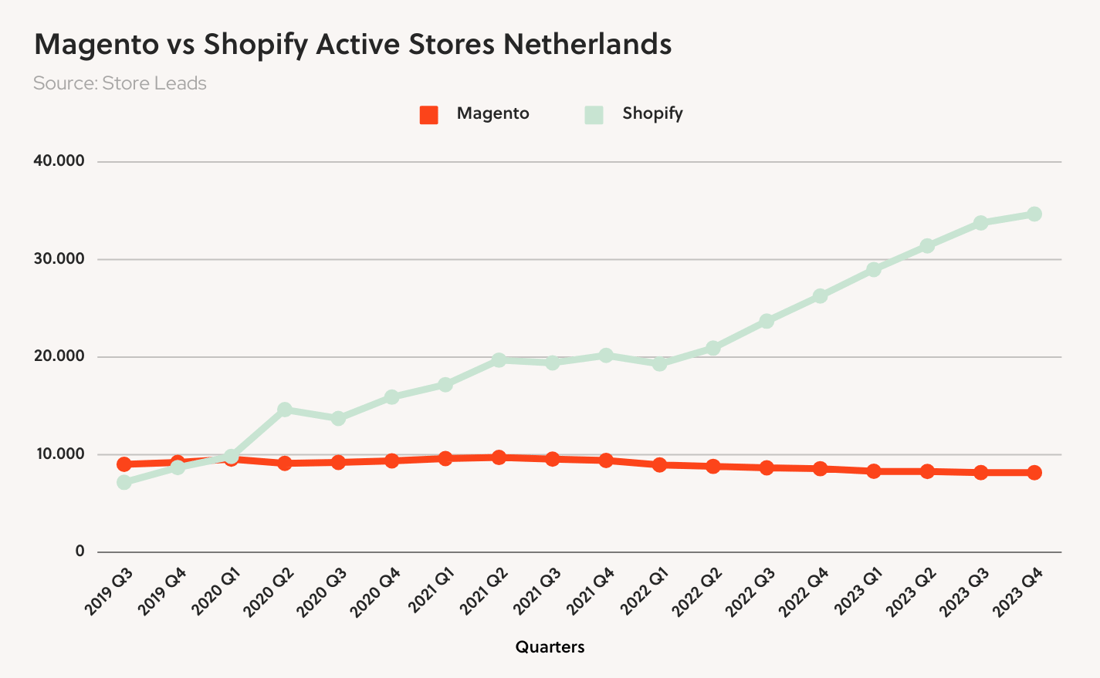Three waves of Magento migrations
Over the years Code has migrated tens of ex-Magento merchants to Shopify throughout Europe (Benelux, DACH, Nordics, UK), and we heared similar stories from all brands. In this blog, we share some of the experiences that prompted our clients to migrate from Magento to Shopify.
First wave: Magento 1 EOL
The first wave of replatformers came to us when Magento 1 reached its End of Life, scheduled for June 2020. An ideal moment for many e-commerce brands to switch from a self-hosted open source platform to a more modern, cloud-native SaaS platform like Shopify.
One of those brands was Veloretti, an ambitious bike brand that had invested 18 months and 6 figures in a Magento 1.9 store, only to learn that they would have to replatform soon because Magento announced the EOL of version 1. Their founder Ferry Zonder was done with it, however, and moved the entire store to Shopify in a matter of weeks.
And then there was the case of Rosefield Watches. For them, Magento was a nightmare from the start and they didn’t even make it to the EOL before replatforming.
“We were held hostage by our platform. We couldn’t touch anything without breaking things. To get the functionality we needed, we started doing things with the platform that it was never designed for. Our lives were completely dictated by it, we kept spending tons of energy on it, and the costs kept soaring.”
Since Rosefield moved to Shopify Plus they went on to conquer the international market of jewelry and watches.
Second wave: Magento 2 disappoints
We saw a second wave when a number of businesses regretted their upgrade to Magento 2 so much that they abandoned it within a year and moved to Shopify. Their main concern was often cost: maintaining Magento 2 turned out to be extremely expensive, while not delivering the performance clients needed.
The coffee roasters at Fascino came away from their 18 months with Magento 2 slightly traumatized. Co-founder Lieke Hanssen summed it up at the time: “The platform simply cost us way too much money. When our developer agency handed us a pricy estimate for the next Magento release, we had no other choice than to replatform.” Not surprisingly, the thing she liked most about Shopify was the absence of platform maintenance. “With Shopify, you don’t have towering maintenance costs and unexpected releases that make your business operations unpredictable. You know what every month will bring in terms of costs, so there’s enough budget left for marketing.”
Cost was definitely a factor in the case of McGregor New York, too, in combination with the platform performing poorly. “Our IT landscape was so heavily customised that it crashed regularly. The checkout often didn’t work, every time there was a sale or campaign something went wrong, conversion was plummeting, we needed our Magento development agency for everything, people had to work weekends to keep the platform in the air, and a lot of the budget went to IT and damage control.” On top of that, it turned out that a new Magento update would cost as much as building a new store. McGregor decided to switch to Shopify and saw its revenue go up again, without crashes and overwork.

Third wave: Shopify builds more and more momentum
Currently, we are witnessing a third wave: brands who feel Magento - correction: since 2021 the commercial version is called Adobe Commerce - runs the risk of getting out of touch. Compared to Shopify, the platform’s approach is simply not up-to-date anymore: the future is SaaS, relentless innovation is key, and the constant rhythm of EOL’s and updates is wearing them out.
Swiss brand namuk is a recent migration client of Code’s. Head of E-commerce Simon Bertschinger wasted no time moving the brand to a SaaS platform when he started: "Maintaining our Magento webshop took us around 140 hours per month - and that was even without the implementation of new features. Our store had many issues: speed, payment systems… and the options for personalization were way too complex." Since the migration, the brand’s ambition to scale internationally has gained unprecedented momentum. “Shopify Plus creates more possibilities and flexibility, allowing us to develop our brand much faster."
At the moment of writing this blog (Fall 2023), Code just finished migrating German pet brand MiaCara to Shopify. They were still on Magento 1, crutched by extensive third-party support, and time was running out. “We realized that moving to Magento 2 wouldn't give us much of an advantage over Magento 1, where speed, user-friendliness and cost of development were a problem. So we assessed the available alternatives and found that Shopify beat the other contenders in almost every category that was relevant to us: Total Cost of Ownership, speed of development, amount of relevant users at the moment, pace of innovation and momentum in general.”
Secure your migration with Code
Is your brand considering to move away from Magento? Then it’s worthwhile to look into Shopify. Over the years, Shopify has evolved from a small business solution with a ‘template reputation’ into the most cutting-edge e-commerce solution available for brands of all sizes: from small, to mid market all the way up to enterprise (+150 mio GMV).
→ Read 5 reasons why Shopify is your best bet in this blog
→ Get direct insight into the costs of a Shopify online store for your brand. Try our TCO calculator for a personalized calculation, including Shopify fees, Apps and (ongoing) Store development.
Are you looking for an experienced agency partner to embark on your migration? Make sure to check out Code. From the moment we became the first official Shopify Plus Partner in the EU, we’ve been building and scaling hundreds of Shopify stores and we are now named Shopify Premier Partner and considered one of the top Shopify agencies on the European mainland.
Check out our previous work to see what we can do, and get in touch!



.png)